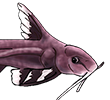Zeng Y-Y, Pu X-R, Lei H-T, Oo TN, & X-Y Chen. (2025). A taxonomic review of Bagarius catfish (Siluriformes, Sisoridae) in the Salween and Irrawaddy rivers, with descriptions of two new species from China and Myanmar. Zoosystematics and Evolution, 101(3), 1123-1136.
https://doi.org/10.3897/zse.101.145776
Key Words: Cryptic species, phylogeny, Southeast Asia, taxonomyAbstract
The genus Bagarius is a group of large, benthic, predatory catfishes found in South and Southeast Asia. Two new species of Bagarius, B. protos Zeng & Chen, sp. nov., and B. dolichonema Zeng & Chen, sp. nov., are described from the Salween River Basin, Yunnan Province, China, and Irrawaddy River Basin, Myanmar, respectively. Bagarius protos and B. dolichonema both differ from B. vegrandis and B. suchus in their large size and the adipose-fin origin being nearly vertical to the anal-fin origin. Bagarius protos most closely resembles B. lica and B. rutilus in overall morphology but can be distinguished from B. lica by the absence of the brow ridge formed by the lateral margin of the frontal and from B. rutilus by the dark yellow (instead of orange) coloration of the fins in life. It further differs from two other congeners in its short filamentous extensions of the pectoral-fin spine. Bagarius dolichonema is morphologically and genetically most similar to B. bagarius; it can be distinguished from B. bagarius by strong dorsal spines slightly flattened immediately anterior to the adipose fin, distally slender neural spines of the 4th–6th vertebrae, and shorter filamentous extensions of the pectoral-fin spine. This new species further differs from three other congeners by its longer filamentous extensions of the pectoral-fin spine and weak notches in the anterodorsal margin of the first dorsal pterygiophores. Molecular phylogeny based on the cytochrome c oxidase subunit I (COI) gene also confirms the validity of these two new species. The estimated K2P genetic distances between B. protos and congenerics range from 8.0% to 12.6%, and between B. dolichonema and congenerics range from 5.7% to 12.1%.








